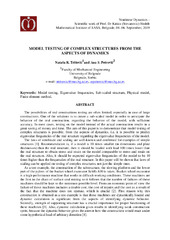Приказ основних података о документу
Model testing of complex structures from the aspects of dynamics
| dc.creator | Trišović, Nataša | |
| dc.creator | Petrović, Ana | |
| dc.date.accessioned | 2023-03-13T13:44:10Z | |
| dc.date.available | 2023-03-13T13:44:10Z | |
| dc.date.issued | 2019 | |
| dc.identifier.uri | https://machinery.mas.bg.ac.rs/handle/123456789/6000 | |
| dc.description.abstract | The possibilities of real constructions testing are often limited, especially in case of large constructions. One of the solutions is to create a sub-scaled model in order to anticipate the behavior of the real construction, regarding the behavior of the model, with sufficient accuracy. In most cases, testing on the model instead of the actual construction results in a great saving of money and time. The aim of this paper is to demonstrate that model testing of complex structures is possible, from the aspects of dynamics, i.e. it is possible to predict eigenvalue frequencies of the real structure regarding the eigenvalue frequencies of the model. The laws of similitude and scaling are well-known and confirmed for examples of simple structures [1]. Recommendation is, if a model is 10 times smaller (in dimensions and plate thicknesses) than the real structure, then it should be loaded with load 100 times lower than the real structure to obtain stress and strain on the model comparable to stress and strain on the real structure. Also, it should be expected eigenvalue frequencies of the model to be 10 times higher than the frequencies of the real structure. In this paper will be shown that laws of scaling can be applied on testing of complex structures, not just the simple ones. As a test example, the construction of the substructure, the slewing platform and the lower part of the pylons of the bucket wheel excavator SchRs 630 is taken. Bucket-wheel excavator is a high-performance machine that works in difficult working conditions. These machines are the first in the chain of surface coal mining so it follows that the number of failures of these machines should be kept to the minimum possible level. From an economic point of view the failure of those machines includes a double cost, the cost of repairs and the cost as a result of the fact that the machine does not operate, which is crucial [2]. First reason why this construction is obtained as a test example is that those machines are dynamically loaded and dynamic calculation is significant from the aspects of identifying dynamic behavior. Secondly, strength of supporting structure has a crucial importance for proper functioning of these machines [3]. Also, dynamic calculation gives results in identifying weak construction spots, because the dynamic behavior gives the answer how the construction would react under some hypothetical load of arbitrary direction [4]. Nataša R. Trišović and Ana S. Petrović. Numerical calculations of the real construction and sub-scaled model were performed using Finite Element Method. Eigenvalue frequencies of the real construction and model are obtained in correlation as expected. In that way scaling laws are confirmed for this structure and similar structures. Physical model of this construction is made (from the same material as the real structure). Static experiments on physical model validated all numerical models (of the real structure and its sub-scaled model) and indirectly validated dynamic calculations. It also confirmed that 10 times reduction in dimensions and thicknesses is justified. So, physical model represents the real structure, in both dynamic and static aspects, and is ready for further dynamic testing in the laboratory. REFERENCES [1] Liang Z., Reinhorn A.M., Experimental Methods in Structural Engineering, Chapter 2 - Modeling and Similitude, http://civil.eng.buffalo.edu/cie616/2-LECTURES/Lecture 2 - Modeling and Scaling/Chapter2.pdf [2] Dreyer, E. (1995) “Cost-effective prevention of equipment failure in the mining industry,” International Journal of Pressure Vessels and Piping, Vol. 61, No. 2-3, pp. 329- 347. [3] Bošnjak, S.; Pantelić,, M.; Zrnić, N.; Gnjatović, N.; Đorđević, M. (2011) “Failure analysis and reconstruction design of the slewing platform mantle of the bucket wheel excavator O&K SchRs 630, ” Engineering Failure Analysis, Vol. 18, No. 2, pp. 658-669. [4] Allaboudi, E.; Maneski, T.; Trišović, N.; Ergić, T. (2013) “Improving Structure Dynamic Behaviour Using a Reanalysis Procedures Technique,” Technical Gazette, Vol. 20, No. 2, pp. 297-304. | sr |
| dc.language.iso | en | sr |
| dc.relation | info:eu-repo/grantAgreement/MESTD/Technological Development (TD or TR)/35040/RS// | sr |
| dc.relation | info:eu-repo/grantAgreement/MESTD/Technological Development (TD or TR)/35011/RS// | sr |
| dc.rights | openAccess | sr |
| dc.rights.uri | https://creativecommons.org/licenses/by-nc-nd/4.0/ | |
| dc.source | The Symposium “Nonlinear dynamics - Scientific work of Prof. Dr Katica (Stevanovic) Hedrih” | sr |
| dc.subject | Model testing | sr |
| dc.subject | Eigenvalue frequencies | sr |
| dc.subject | Sub-scaled structure | sr |
| dc.subject | Physical model | sr |
| dc.subject | Finite element method | sr |
| dc.title | Model testing of complex structures from the aspects of dynamics | sr |
| dc.type | conferenceObject | sr |
| dc.rights.license | BY-NC-ND | sr |
| dc.citation.rank | M34 | |
| dc.identifier.fulltext | http://machinery.mas.bg.ac.rs/bitstream/id/14872/bitstream_14872.pdf | |
| dc.identifier.rcub | https://hdl.handle.net/21.15107/rcub_machinery_6000 | |
| dc.type.version | publishedVersion | sr |


